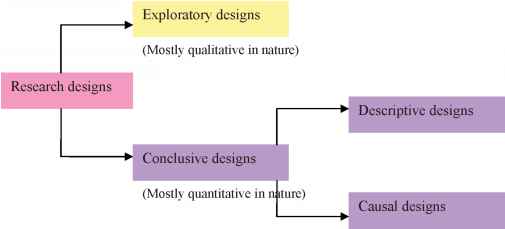Exploratory research design
2.1 Chapter summary
This chapter will start with defining research design, classifying various designs and explaining the difference between exploratory and conclusive research designs by comparing and contrasting the basic research designs: exploratory, descriptive and causal. It will explain how the problem definition is linked with the selection of research design and will then explore the exploratory research design in detail. It will provide classification of exploratory research design and discuss important research techniques such as in-depth interviews, focus groups and projective techniques.
2.2 Research design and its importance in research
The term 'research design' is used in variety of ways by researchers. It is referred as a masterplan, blueprint, and even as a sequence of research tasks and activities. Research design in simple terms is a plan of the methods and procedures that is used by researchers to collect and analyze the data needed by the manager. The research design provides a plan of how the researcher will go about answering the research question(s) defined by the manager and researcher together (clearly defining the problem into a researchable question is extremely important). The research design also contains clear objectives, derived from research question(s), specify the information sources from which data will be collected, the type of data, the design technique(s) (survey, observation, experimentation etc.), the sampling methodology and procedures, the schedule and the budget. There should be clear justification with regard to the research design based on the research question and objectives.
As stated above, the purpose of any research design is to obtain evidence which addresses the research question and objectives. Usually, however, there are a number of ways in which it can be achieved. Although, every research question is unique, most research objectives can be met by using one of the three types of research designs: exploratory, descriptive and causal. In real-life situations, while addressing research question and objectives a researcher needs to make number of trade-offs with regard to various elements of research design.
Research design holds all the parts and phases of the research project together. A poorly developed design fails to provide accurate answers to the research question under investigation and in turn does not assist the manager in the decision making process. The foundations of research design are firmly based on scientific rigour and objectivity. Any personal, procedural, or methodological bias involved in research design will have an impact on entire research process. Therefore, developing a sound research design is an extremely important aspect of any research project.
2.3 Classification and differences between research designs
Researchers have mixed different styles of inquiries for many years. They have recognized that all methods have their inherent strengths and weaknesses. Most researchers broadly classify research designs into two types: exploratory and conclusive. Furthermore, some researchers classify conclusive research designs as descriptive or causal. Therefore, there are 3 major classifications of research designs namely; exploratory, descriptive and causal.
Figure 2.1:
Classification of research designs
Figure 2.1:
Classification of research designs

The research designs involve two types of data collection: secondary and primary. Secondary data involves collection of data that already exists. These data may be collected and assembled for some research problem situation other than the current situation. Secondary data and analysis is useful at all stages of the marketing research process. However, it is particularly useful at the problem definition and exploratory research design stage. Secondary data mostly involves desk or library research and can serve managers' needs for information on their markets, competitors, customers and overall environment. In some cases if done thoroughly, secondary data collection can solve the research problem at hand without requiring more expensive stage of primary data collection. The table below provides examples of several secondary data sources. Please remember the table below provides a generic idea and is not an exhaustive list.
Table 2.1:
Secondary data sources
Table 2.1:
Secondary data sources
|
Data source |
Example |
|
Internal data |
In company reports, memos etc. |
|
Syndicated data |
Syndication services like AC Nielson |
|
Expert advice |
Newspaper, interviews, reports |
|
Internet |
Various search engines, portals and websites |
|
Industry data |
Industry or trade associations |
|
Macro data |
Government and international publications |
|
Market research report |
Independent market research firms |
Continue reading here: Conclusive research design
Was this article helpful?
Readers' Questions
-
Girma4 months ago
- Reply
-
herbert12 months ago
- Reply
-
allan1 year ago
- Reply
-
mary1 year ago
- Reply
-
SUSANNA1 year ago
- Reply
-
Simon1 year ago
- Reply
-
christopher1 year ago
- Reply
-
walter1 year ago
- Reply
-
DARREN1 year ago
- Reply
-
DEMSAS1 year ago
- Reply
-
simret1 year ago
- Reply
-
vilma1 year ago
- Reply
-
haile temesgen1 year ago
- Reply
-
elias1 year ago
- Reply
-
Oskari1 year ago
- Reply
-
Doroteo1 year ago
- Reply